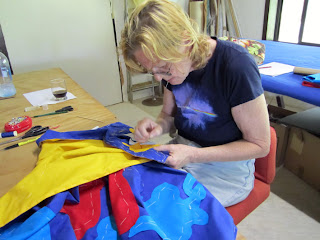Every year, the holiday season feels odd to me, as in this warm and sunny climate and the souterhn hemisphere’s summer I find it hard to develop Christmas feelings. Christmas for me comes along with early darkness and cold weather, quality time inside the home, foods that keep you warm and hot chocolates or toddies.
On our island, this year’s end is sunny, but not yet as hot as it has been most other years. I really appreciate this, because it makes working easier. One doesn’t dribble sweat all over the work... The last element of my installation is in the sewing machine. Soon I will be able to bundle them up to send them to Sydney.
 |
| Jeanne Humphreys with her recently finished painting |
I had a lovely visit from a Cook Islands friend who is from Atiu, but lives in Christchurch most of the time. Jeanne Humphreys is a painter. We had spoken on the phone about her last work in progress, a special commission that she had only been reluctant to accept. I know from my own experience that at times it can be hard to force your creativity to follow someone else’s dreams. I was happy when she brought along her friend Penny and her finished painting to show me. Her client, a masseur, had wanted hands to feature in the painting. Jeanne’s friend Penny admired the detailed work in which she could “even see the fingerprints”. I enjoyed that Jeanne shared her finished work with me as a special Christmas treat before she left the island again to celebrate Christmas with her children.
Juergen and I celebrated Christmas the German way, on Christmas Eve. This year we had decided not to have a tree and just enjoyed a nice dinner together. I had given Juergen a DVD that showed features from his birth year, 1942. It was interesting to watch and catch up with some history. Learning about the fashion of that year was what I enjoyed the most. But the film clips were, of course, taken from British, American and Australian footage. We would have enjoyed seeing what happened that year in war-torn Germany. It must have been so hard for Juergen’s mother, who already had a three-year-old girl to look after and whose husband was at war, to give birth to this little boy who is now my husband. I know from the stories my mother told me, who was in Berlin during the war, that it was terrible there. Everybody was hungry and afraid. Winter was cold in the bombed houses. People were poor. Many, like my mother, had lost their homes and everything in it and had to make do with what friends shared with them. Life was a daily struggle for ordinary people, how much more so for a young mother who, at Christmas 1942 had two children who were born on the exact same day eight months back, but three years apart.
I am glad that today we are safe and satisfied, living a peaceful life on our little island. But I am sad for all those who are not as lucky as we are. Nearly 70 years later, the world is still not at peace and there are mothers in this world who are hungry at the end of this year, who worry about what to feed their children the next day, how to keep them alive for another year, and what their lives will be like. I feel for them and wish them strength to survive the bad times. I wish them the same good fortune our mothers had: to live through war’s end and in more peaceful times, seeing their children grow up into educated and healthy adults with children of their own.
I wish all of you, my friends, happy holidays, merry Christmas or whatever you chose to celebrate these days in the company of your loved ones or, if you preferred, on your own. Enjoy the snow, the sunshine, a family meal inside a well-heated home or a picnic at the beach.























































